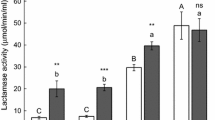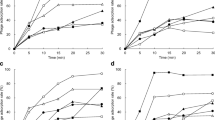Abstract
This study was designed to evaluate the combined effects of bacteriophage and antibiotic on the reduction of the development of antibiotic-resistance in Salmonella typhimurium LT2. The susceptibilities of S. typhimurium to ciprofloxacin and erythromycin were increased when treated with bacteriophages, showing more than 10% increase in clear zone sizes and greater than twofold decrease in minimum inhibitory concentration values. The growth of S. typhimurium was effectively inhibited by the combination of bacteriophage P22 and ciprofloxacin. The combination treatment effectively reduced the development of antibiotic resistance in S. typhimurium. The relative expression levels of efflux pump-related genes (acrA, acrB, and tolC) and outer membrane-related genes (ompC, ompD, and ompF) were decreased at all treatments. This study provides useful information for designing new antibiotic therapy to control antibiotic-resistant bacteria.




Similar content being viewed by others
Change history
12 June 2018
In the original version of these 14 articles the reference list was unfortunately not represented according to the journal’s new bibliographical style, which should have been implemented from January 2018.
References
Acheson D, Hohmann EL. Nontyphoidal Salmonellosis. Clin. Infect. Dis. 32: 263–269 (2001)
Ao TT, Feasey NA, Gordon MA, Keddy KH, Angulo FJ, Crump JA. Global burden of invasive nontyphoidal Salmonella disease. Emerg. Infect. Dis. 21: 941–949 (2015)
Bardina C, Spricigo DA, Cortes P, Llagostera M. Significance of the bacteriophage treatment schedule in reducing Salmonella colonization of poultry. Appl. Environ. Microbiol. 78: 6600–6607 (2012)
Bielke L, Higgins S, Donoghue A, Donoghue D, Hargis BM. Salmonella host range of bacteriophages that infect multiple genera. Poul. Sci. 86: 2536–2540 (2007)
Chaudhry WN, Concepción-Acevedo J, Park T, Andleeb S, Bull JJ, Levin BR. Synergy and order effects of antibiotics and phages in killing Pseudomonas aeruginosa biofilms. PLoS ONE 12: e0168615 (2017)
Comeau AM, Tétart F, Trojet SN, Prère M-F, Krisch HM. Phage-antibiotic synergy (PAS): β-Lactam and quinolone antibiotics stimulate virulent phage growth. PLoS ONE 2: e799 (2007)
Dahshan H, Shahada F, Chuma T, Moriki H, Okamoto K. Genetic analysis of multidrug-resistant Salmonella enterica serovars Stanley and Typhimurium from cattle. Vet. Microbiol. 145: 76–83 (2010)
Giedraitienė A, Vitkauskienė A, Naginienė R, Pavilonis A. Antibiotic resistance mechanisms of clinically important bacteria. Medicina 47: 137–146 (2011)
Jo A, Ding T, Ahn J. Synergistic antimicrobial activity of bacteriophages and antibiotics against Staphylococcus aureus. Food Sci. Biotechnol. 25: 935–940 (2016)
Kamal F, Dennis JJ. Burkholderia cepacia complex phage-antibiotic synergy (PAS): Antibiotics stimulate lytic phage activity. Appl. Environ. Microbiol. 81: 1132–1138 (2015)
Kobayashi N, Tamura N, van Veen HW, Yamaguchi A, Murakami S. β-Lactam selectivity of multidrug transporters AcrB and AcrD resides in the proximal binding pocket. J. Biol. Chem. 289: 10680–10690 (2014)
Labrie SJ, Samson JE, Moineau S. Bacteriophage resistance mechanisms. Nat. Rev. Microbiol. 8: 317–327 (2010)
Lin H-L, Lin C-C, Lin Y-J, Lin H-C, Shih C-M, Chen C-R, Huang R-N, Kuo T-C. Revisiting with a relative-density calibration approach the determination of growth rates of microorganisms by use of optical density data from liquid cultures. Appl. Environ. Microbiol. 76: 1683–1685 (2010)
Livak KJ, Schmittgen TD. Analysis of relative gene expression data using real-time quantitative PCR and the 2−∆∆CT Method. Method. 25: 402–8 (2001)
Mather AE, Reid SW, Maskell DJ, Parkhill J, Fookes MC, Harris SR, Brown DJ, Coia JE, Mulvey MR, Gilmour MW, Petrovska L, de Pinna E, Kuroda M, Akiba M, Izumiya H, Connor TR, Suchard MA, Lemey P, Mellor DJ, Haydon DT, Thomson NR. Distinguishable epidemics of multidrug-resistant Salmonella Typhimurium DT104 in different hosts. Science 341: 1514–7 (2013)
Michael GB, Schwarz S. Antimicrobial resistance in zoonotic nontyphoidal Salmonella; an alarming trend? Clin. Microbiol. Infect. 22: 968–974 (2016)
Miró E, Vergés C, García I, Mirelis B, Navarro F, Coll P, Prats G, Martínez-Martínez L. Resistance to quinolones and β-lactams in Salmonella enterica due to mutations in topoisomerase-encoding genes, altered cell permeability and expression of an active efflux system. Enferm. Infecc. Microbiol. Clin. 33: 204–211 (2015)
Moya-Torres A, Mulvey MR, Kumar A, Oresnik IJ, Brassinga AKC. The lack of OmpF, but not OmpC, contributes to increased antibiotic resistance in Serratia marcescens. Microbiol. 160: 1882–1892 (2014)
Muniesa M, Colomer-Lluch M, Jofre J. Potential impact of environmental bacteriophages in spreading antibiotic resistance genes. Future Microbiol. 8: 739–751 (2013)
Nikaido E, Yamaguchi A, Nishino K. AcrAB multidrug efflux pump regulation in Salmonella enterica serovar Typhimurium by RamA in response to environmental signals. J. Biol. Chem. 283: 24245–24253 (2008)
Nikaido H, Basina M, Nguyen V, Rosenberg EY. Multidrug efflux pump AcrAB of Salmonella typhimurium excretes only those beta-lactam antibiotics containing lipophilic side chains. J. Bacteriol. 180: 4686–92 (1998)
Oechslin F, Piccardi P, Mancini S, Gabard J, Moreillon P, Entenza JM, Resch G, Que Y-A. Synergistic interaction between phage therapy and antibiotics clears Pseudomonas aeruginosa infection in endocarditis and reduces virulence. J. Infect. Dis. 215: 703–712 (2017)
Perera MN, Abuladze T, Li M, Woolston J, Sulakvelidze A. Bacteriophage cocktail significantly reduces or eliminates Listeria monocytogenes contamination on lettuce, apples, cheese, smoked salmon and frozen foods. Food Microbiol. 52: 42–48 (2015)
Piddock LV. Understanding the basis of antibiotic resistance: a platform for drug discovery. Microbiol. 160: 2366–2373 (2014)
Prestinaci F, Pezzotti P, Pantosti A. Antimicrobial resistance: a global multifaceted phenomenon. Pathog. Glob. Health 109: 309–318 (2015)
Rakhuba DV, Kolomiets EI, Dey ES, Novik GI. Bacteriophage receptors, mechanisms of phage adsorption and penetration into host cell. Pol. J. Microbiol. 59: 145–155 (2010)
Ricci V, Piddock LJ. Only for substrate antibiotics are a functional AcrAB-TolC efflux pump and RamA required to select multidrug-resistant Salmonella Typhimurium. J. Antimicrob. Chemother. 64: 654–7 (2009)
Rushdy AA, Mabrouk MI, Abu-Sefa FA-H, Kheiralla ZH, -All SMA, Saleh NM. Contribution of different mechanisms to the resistance to fluoroquinolones in clinical isolates of Salmonella enterica. Braz. J. Infect. Dis. 17: 431–437 (2013)
Ryan EM, Alkawareek MY, Donnelly RF, Gilmore BF. Synergistic phage-antibiotic combinations for the control of Escherichia coli biofilms in vitro. FEMS Immunol. Med. Microbiol. 65: 395–398 (2012)
Spricigo DA, Bardina C, Cortés P, Llagostera M. Use of a bacteriophage cocktail to control Salmonella in food and the food industry. Int. J. Food Microbiol. 165: 169–174 (2013)
Stecher B, Hapfelmeier S, Müller C, Kremer M, Stallmach T, Hardt W-D. Flagella and chemotaxis are required for efficient induction of Salmonella enterica serovar Typhimurium colitis in streptomycin-pretreated mice. Infect. Immun. 72: 4138–4150 (2004)
Webber MA, Piddock LJV. The importance of efflux pumps in bacterial antibiotic resistance. J. Antimicrob. Chemother. 51: 9–11 (2003)
Acknowledgements
This research was supported by Basic Science Research Program through the National Research Foundation of Korea (NRF) funded by the Ministry of Education (NRF-2016R1D1A3B01008304). This study was supported by a Research Grant from Kangwon National University (2017) (Grant number: D1001438-01-01). This study was also supported by funding from the graduate school of Prince of Songkla University.
Author information
Authors and Affiliations
Corresponding author
Rights and permissions
About this article
Cite this article
Petsong, K., Uddin, M.J., Vongkamjan, K. et al. Combined effect of bacteriophage and antibiotic on the inhibition of the development of antibiotic resistance in Salmonella typhimurium. Food Sci Biotechnol 27, 1239–1244 (2018). https://doi.org/10.1007/s10068-018-0351-z
Received:
Revised:
Accepted:
Published:
Issue Date:
DOI: https://doi.org/10.1007/s10068-018-0351-z




